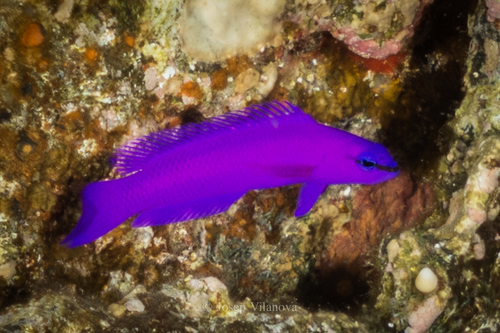
Orchid Dottyback
The Atlantic Bluefin Tuna (Thunnus thynnus) is a highly migratory, large pelagic fish renowned for its size, speed, and commercial value. As one of the ocean's top predators, it plays a crucial role in the marine ecosystem.
5 8 years
Lifespan
7 cm
Length
Least Concern
Conservation Status
null km/h
Swimming speed
Carnivorous
Diet
Sedentary
Migration
Appearance Overview
The Atlantic Bluefin Tuna showcases a robust, streamlined body, perfectly adapted for speed and endurance in the water.
Color
Dark metallic blue above, shimmering silvery-white below
Body shape
Torpedo-like, designed for efficient swimming
Fins
Two dorsal fins, the first depressible; small finlets running down the back and belly towards the tail
Length
Up to 13 feet (4 meters)
Weight
Up to 2,000 lbs (907 kg)
Diet
Carnivorous, feeding on a variety of fish, squid, crustaceans, and occasionally, zooplankton and eels.
Feeding Behavior
Highly active predator, using speed and agility to hunt; often hunts cooperatively, herding prey into tighter formations.
Social Behavior
Forms schools that can vary in size, sometimes segregating by size; known for long migrations across oceans.
Commercial Relevance
Extremely high value, especially in sushi and sashimi markets, where it's considered a delicacy.
Conservation measures
Subject to international fishing quotas, stock assessments, and management plans aimed at rebuilding populations; marine protected areas also play a role.
Status
Endangered
Threats
Historically overfished to near extinction; ongoing threats include illegal fishing, bycatch in other fisheries, and climate change affecting prey distribution.
Habitat Distribution
Depth Range
0-3,300 feet (0-1,000 meters), though more commonly found in shallower waters.
Geographic Range
North Atlantic Ocean, including the Mediterranean Sea, and the Gulf of Mexico.
Preferred Environment
Primarily pelagic, inhabiting both temperate and subtropical waters; prefers open ocean but also comes closer to shore.
Reproduction and Life Cycle
Breeding Habits
Spawns in warm waters, with major spawning grounds in the Mediterranean Sea and the Gulf of Mexico; spawning typically occurs from spring to summer.
Development Stages
Eggs hatch into larvae that drift with the currents; juveniles grow rapidly, feeding voraciously; they transition through several life stages before reaching adulthood.
Fecundity
Highly fecund; a single female can produce up to 30 million eggs per season, though survival rates of larvae are low.
Maturity Age
Reaches sexual maturity relatively late, around 4-8 years of age, depending on the population.
Faqs about Orchid Dottyback
How long do Atlantic Bluefin Tuna live?
Atlantic Bluefin Tuna can live up to 40 years, though this is less common due to fishing pressures.
How fast can Atlantic Bluefin Tuna swim?
They are among the fastest fish in the ocean, capable of bursts of speed up to 43 mph (70 km/h).
Are Atlantic Bluefin Tuna warm-blooded?
Yes, they are warm-blooded, which allows them to maintain a higher body temperature than the surrounding water, aiding in muscle efficiency during hunting and migration.
Where are Atlantic Bluefin Tuna found?
They are primarily found in the Atlantic Ocean, ranging from Newfoundland to the Mediterranean Sea, and also in the Gulf of Mexico.
How deep can Atlantic Bluefin Tuna dive?
They can dive to depths of over 3,000 feet (900 meters) in search of food.
Do Atlantic Bluefin Tuna migrate?
Yes, they are highly migratory, traveling vast distances across the Atlantic for feeding and spawning.
How many eggs can a female Bluefin Tuna lay?
Females can release millions of eggs per spawning season, which are then externally fertilized by males.
What adaptations do Bluefin Tuna have for their environment?
Their streamlined body, powerful muscles, and specialized fins enable high-speed swimming and deep diving.
Copyright @ Nature Style Limited. All Rights Reserved.
 English
English